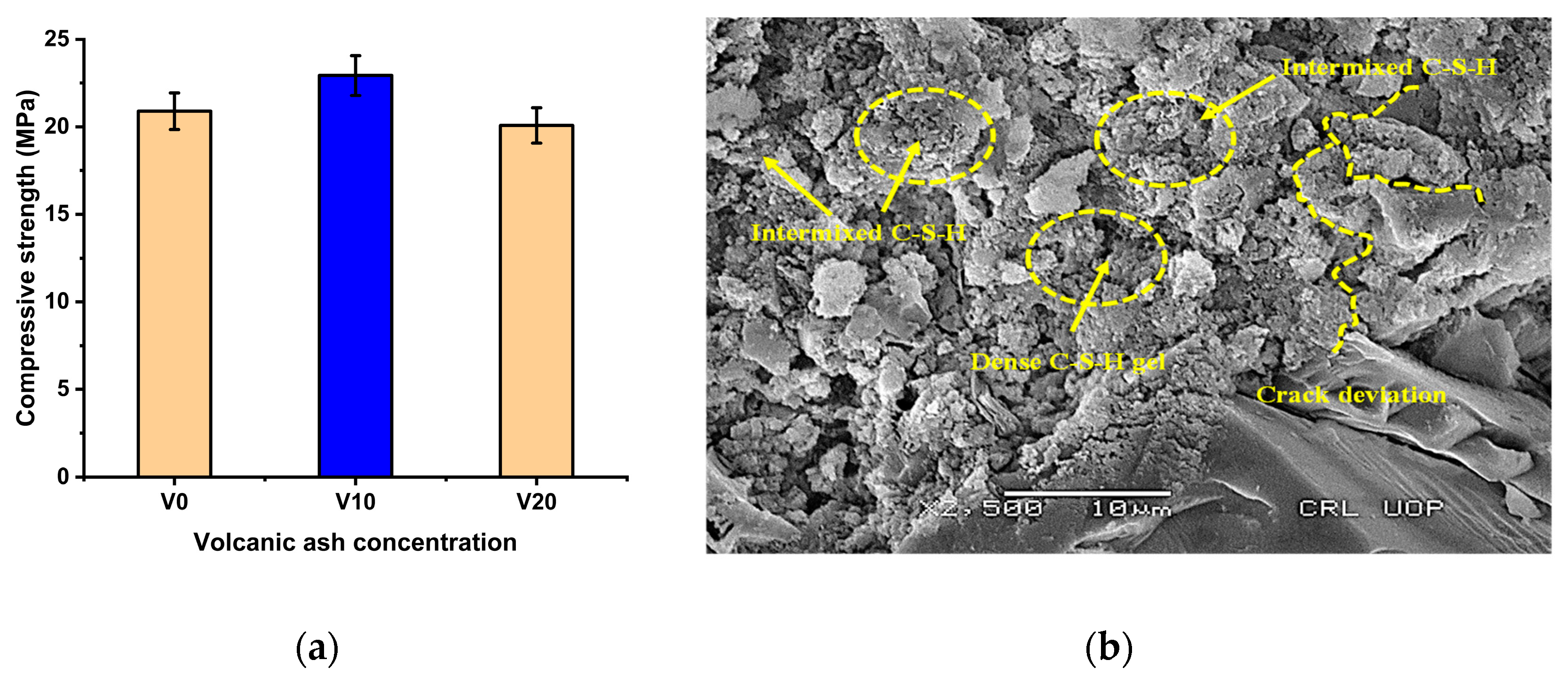Micro Structural Study of Concrete with Indigenous Volcanic Ash †
Abstract
:1. Introduction
2. Experimental Procedures
2.1. Material Used
2.1.1. Volcanic Ash
2.1.2. Cement
2.1.3. Coarse/Fine Aggregate
2.2. Concrete Mix Proportion
Sample Preparation
2.3. Tests Performed
Compressive Strength and Scanning Electron Microscopy of the Concrete
3. Results and Discussions
3.1. Compressive Strength and Microstructure of VA Concrete 1:2:4
3.2. Cost Benefit Analysis
4. Conclusions
- The compressive strength of concrete with 10% VA replacement enhances the composite strength compared to the control specimen;
- SEM analysis reveals that VA particles react with the CH to form densified C-S-H gel. In addition, deviation of cracks is observed, which is a good sign for strength and durability;
- Incorporating Volcanic Ash (VA) in concrete construction leads to a significant cost reduction of 11% when considering the desired compressive strength.
Author Contributions
Funding
Institutional Review Board Statement
Informed Consent Statement
Data Availability Statement
Acknowledgments
Conflicts of Interest
References
- Akbar, A.; Farooq, F.; Shafique, M.; Aslam, F.; Alyousef, R.; Alabduljabbar, H. Sugarcane bagasse ash-based engineered geopolymer mortar incorporating propylene fibers. J. Build. Eng. 2021, 33, 101492. [Google Scholar] [CrossRef]
- AlKhatib, A.; Maslehuddin, M.; Al-Dulaijan, S.U. Development of high performance concrete using industrial waste materials and nano-silica. J. Mater. Res. Technol. 2020, 9, 6696–6711. [Google Scholar] [CrossRef]
- Siddique, R. Properties of concrete made with volcanic ash. Resour. Conserv. Recycl. 2012, 66, 40–44. [Google Scholar] [CrossRef]
- Keshta, M.M.; Yousry Elshikh, M.M.; Kaloop, M.R.; Hu, J.W.; ELMohsen, I.A. Effect of magnetized water on characteristics of sustainable concrete using volcanic ash. Constr. Build. Mater. 2022, 361, 129640. [Google Scholar] [CrossRef]
- Anwar Hossain, K.M. High strength blended cement concrete incorporating volcanic ash: Performance at high temperatures. Cem. Concr. Compos. 2006, 28, 535–545. [Google Scholar] [CrossRef]
- Alqarni, A.S. A comprehensive review on properties of sustainable concrete using volcanic pumice powder ash as a supplementary cementitious material. Constr. Build. Mater. 2022, 323, 126533. [Google Scholar] [CrossRef]


| Chemical Composition | Physical Composition | ||
|---|---|---|---|
| Oxide | VA (%Age by Mass) | Characteristics | VA |
| SiO2 | 53.69 | Specific Gravity | 2.67% |
| Al2O3 | 17.43 | Soundness | No Expansion |
| Fe2O3 | 9.52 | Retain on sieve # 325 max (%) | 33 |
| CaO | 7.00 | ||
| MgO | 3.87 | ||
| Na2O | 3.57 | ||
| K2O | 0.86 | ||
| SO3 | 0.16 | ||
| Lime saturation Factor | 3.89 | ||
| Silica Modulus | 1.99 | ||
| Aluminum Modulus | 1.83 | ||
| L.O. I | 1.3 | ||
| Concrete Mix Composition | |||||
|---|---|---|---|---|---|
| Mixes | Cement (Kg/m3) | Volcanic Ash (Kg/m3) | Water (w/c = 0.5) (Kg/m3) | Fine Aggregate (Kg/m3) | Coarse Aggregate (Kg/m3) |
| Control Sample | 320 | 0 | 160 | 640 | 1280 |
| V10 | 288 | 32 | 160 | 640 | 1280 |
| V20 | 256 | 64 | 160 | 640 | 1280 |
| P.C.C Control Sample | P.C.C with 10% Replacement | |||||
|---|---|---|---|---|---|---|
| Parameters | Quantity | Rates | Amount | Quantity | Rates | Amount |
| Cement | 6.4 Bags | Rs. 1350/Bag | Rs. 8640/- | 5.12 Bags | Rs. 1350/Bag | Rs. 6912/- |
| VA | - | - | - | 64 Kg | Rs. 3/Kg | Rs. 192/- |
| Sand | 16 ft3 | Rs. 80/ft3 | Rs. 1280/- | 16 ft3 | Rs. 80/ft3 | Rs. 1280/- |
| Crush | 32 ft3 | Rs. 110/ft3 | Rs. 3520/- | 32 ft3 | Rs. 110/ft3 | Rs. 3520/- |
| Labor for pouring and curing | 35.311 ft3 | Rs. 30/ft3 | Rs. 1059/- | 35.311 ft3 | Rs. 30/ft3 | Rs. 1059/- |
| Total | 14,499/- | 12,963/- | ||||
| Cost reduction | Rs. 1536/Cum (11%) | |||||
Disclaimer/Publisher’s Note: The statements, opinions and data contained in all publications are solely those of the individual author(s) and contributor(s) and not of MDPI and/or the editor(s). MDPI and/or the editor(s) disclaim responsibility for any injury to people or property resulting from any ideas, methods, instructions or products referred to in the content. |
© 2023 by the authors. Licensee MDPI, Basel, Switzerland. This article is an open access article distributed under the terms and conditions of the Creative Commons Attribution (CC BY) license (https://creativecommons.org/licenses/by/4.0/).
Share and Cite
Bashir, M.I.; Elahi, A. Micro Structural Study of Concrete with Indigenous Volcanic Ash. Eng. Proc. 2023, 44, 19. https://doi.org/10.3390/engproc2023044019
Bashir MI, Elahi A. Micro Structural Study of Concrete with Indigenous Volcanic Ash. Engineering Proceedings. 2023; 44(1):19. https://doi.org/10.3390/engproc2023044019
Chicago/Turabian StyleBashir, Muhammad Iqbal, and Ayub Elahi. 2023. "Micro Structural Study of Concrete with Indigenous Volcanic Ash" Engineering Proceedings 44, no. 1: 19. https://doi.org/10.3390/engproc2023044019
APA StyleBashir, M. I., & Elahi, A. (2023). Micro Structural Study of Concrete with Indigenous Volcanic Ash. Engineering Proceedings, 44(1), 19. https://doi.org/10.3390/engproc2023044019








